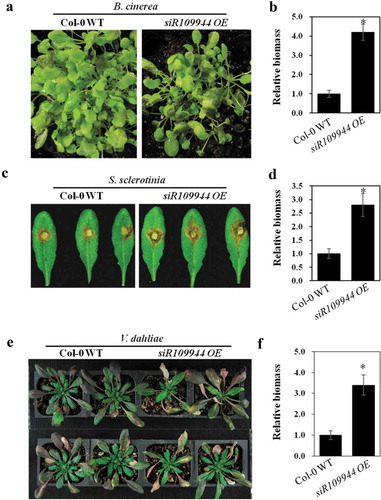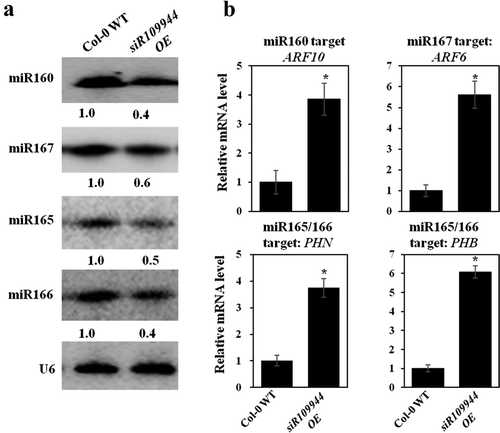Figures & data
Figure 1. Heterologous expression siR109944 suppresses Arabidopsis immunity against fungal infection (a) The phenotypes of Col-0 WT and siR109944 OE Arabidopsis seedlings were inoculated by foliar spraying with Botrytis cinerea spore suspension, and photos were taken 2 days post-inoculation (dpi). (b) The B. cinerea relative DNA content (relative biomass) was measured using quantitative PCR, and error bars represent the standard deviation (s.d.) of three technical replicates. Asterisks indicate significant differences. (c) The phenotypes of Sclerotinia sclerotiorum infect Col-0 WT and siR109944 OE transgenic Arabidopsis, and photos were taken at 2 dpi. (d) The relative biomass of S. sclerotiorum was measured using quantitative PCR, and error bars represent the s.d. of three technical replicates. Asterisks indicate significant differences. (e) Arabidopsis Col-0 WT and siR109944 OE were infected by Verticillium dahliae spores using the root dipping method, and photos were taken at 10 dpi. (f) Relative biomass of V. dahliae was detected by quantitative PCR, and error bars represent the s.d. of three technical replicates. The experiments were repeated three times with similar results. Asterisks indicate significant differences (*P < .05).

Figure 2. Heterologous expression siR109944 affects Arabidopsis auxin-related miRNA expression. (a) The expression levels of auxin-related miRNAs (miR160, miR167, and miR165/166) in Col-0 WT and siR109944 OE plants by northern blot. Values below each section represent the relative abundance (RA) of miRNA normalized to U6. (b) Quantitative PCR analysis of the relative expression of the miR160 target gene ARF10, miR167 target gene ARF6, and miR165/166 target genes PHN and PHB in Col-0 WT and siR109944 OE plants. The internal reference was AtActin. The experiments were repeated three times with similar results. Asterisks indicate significant differences (*P < .05).

